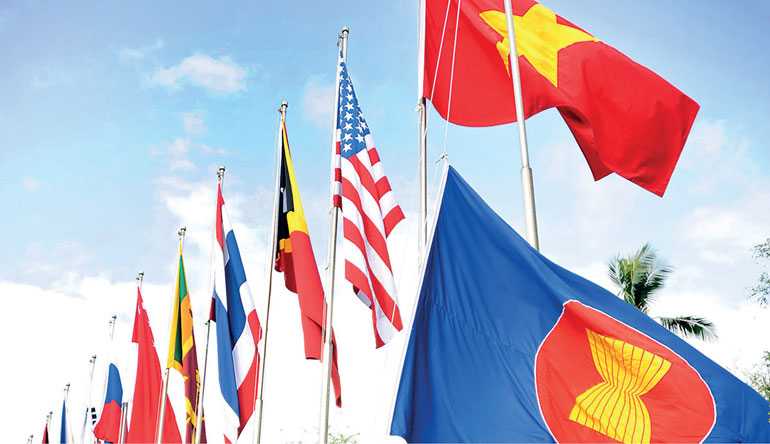Tuesday Mar 04, 2025
Tuesday Mar 04, 2025
Wednesday, 23 May 2018 00:00 - - {{hitsCtrl.values.hits}}

 By Joseph Incalcaterra
By Joseph Incalcaterra
The saying ‘there is strength in diversity’ often comes up when people talk about ASEAN’s cultural differences, but it is also true that economic diversity is one of the bloc’s great strengths.
Despite decades of trade integration, and the creation of the ASEAN Economic Community – which portends to create a dynamic, unified economic zone rivalling the European single market – the region is as diverse as ever. Moreover, a broad-based composition of activity within economies should make growth more resilient in 2018, allowing for monetary policy tightening in places like Malaysia and Singapore, as we discuss below.
Over the longer term, however, a stronger degree of economic integration is the best way to accentuate ASEAN’s economic diversity and prepare for challenges, such as greater manufacturing competition from China. As ASEAN chair, we believe Singapore is best placed to help make this happen in 2018.
Composition of growth and the
commodity engine
Let’s first look at the current composition of growth. We can start with electronics. Economies such as Singapore, Malaysia, Thailand, the Philippines, and Vietnam are all plugged into Asia’s electronics supply chain – albeit in vastly different capacities, from chip production in Singapore to final product assembly in Vietnam.
China’s demand for consumer electronic components jolted ASEAN’s semiconductor supply chain into action, while Vietnam has seen a significant capacity build-up as it becomes the assembler-of-choice for Korean producers: LG just opened an OLED factory in Hai Phong to produce OLED screens for Chinese customers, while Samsung already assembles 50% of its phones near Hanoi.
Then there is the commodity engine. It was fired up this year thanks to strong Chinese demand as the Mainland’s economy enjoyed a surprisingly broad investment recovery, with property leading the way. That said, if we are correct in believing that China’s construction activity has peaked as a share of GDP, ASEAN’s commodity exports may dim somewhat. Yet bear in mind that ASEAN’s outright commodity play is actually becoming a less important driver of exports and overall growth.
For example, Malaysia is investing heavily in downstream industries to anticipate further declines in oil and gas production, and Indonesia continues to facilitate a higher share of value-add in domestic mineral ore mining.
As for ASEAN’s largest crude commodity exports – palm oil and coal – demand should prove resilient. Indonesia’s coal exports to China are booming thanks to the Mainland’s preference for the archipelago’s low sulfur variety over its own for electricity generation – a function of new environmental policies. Meanwhile, demand for palm oil – a sector that Indonesia and Malaysia dominate with 80% of global production - is expected to continue accelerating alongside fast population growth in India and Africa.
The ASEAN consumer
Of course, we would be remiss if we didn’t mention the ASEAN consumer. It is at first glance surprising that private consumption slowed in places like Indonesia and the Philippines this year, considering the improving fundamentals. At a closer look, it appears the slowdown was mostly due to ephemeral factors, such as a push for higher tax revenues and changing government spending patterns in Indonesia; or remittance volatility and urbanisation-induced labour market changes in the Philippines. These should normalise in 2018.
The consumer story will likely remain salient for ASEAN – buttressed by strong population growth and conducive macro policies over the long term. In the short term, there is the election angle to look out for. Malaysia’s general elections in 2018 should boost spending on bread and butter services (or nasi lemak and kaya, if you prefer).
Roughly 90m Indonesians will vote in regional elections in June, and the presidential campaign for the April 2019 elections is expected to start in October 2018. In Thailand, the military government has promised an election by November 2018, but it is unclear what it might mean, if anything, for spending.
With the majority of ASEAN output confined to the services sector, firing up growth here is key for the employment outlook. Manufacturing growth alone will not provide enough support for the labour market – which helps explain the coexistence of strong export data alongside tepid private consumption over the past year and a half, especially in Thailand and Singapore.
Take Singapore as an example: semiconductor production contributed nearly 50% of GDP growth in the third quarter of 2017, while only employing 1% of the labour force. It should, therefore, be no surprise that the recovery in private consumption has lagged the pick-up in exports.
Investment
We’ve covered private consumption and exports – which leaves us with investment. And we believe this will be a clear growth driver across ASEAN. Most notably, public investment in infrastructure has become an important driver of the overall investment outlook, particularly in the Philippines, Indonesia, and Thailand. Most of this is funded with central government budgets; however, in places like Indonesia, Malaysia, and Vietnam, there isn’t much room to manoeuvre because there are constitutionally imposed limits on spending.
This is where China comes in. While sometimes dismissed as nothing more than a headline-generating diplomatic initiative, Belt and Road projects will, we argue, have a tangible impact on ASEAN economies over the next five years, especially Malaysia, Indonesia, and the Philippines.
In each country, we estimate there are projects worth c10-15% of GDP in the pipeline – and we are confident that many of them, especially the railway lines, energy generation plants, and port facilities, will eventually be realised, given their strategic nature for China.
However, these projects are neither free aid nor equity investments – instead, they are largely debt-financed projects, built by Mainland contractors with a high degree of import content that will put some pressure on current accounts. Given that ASEAN faces a significant infrastructure financing gap, this is still a welcome development.
All in all, as domestic demand picks up further in the coming quarters, labour markets should become more resilient. And it is precisely this broader, more stable economic story that we believe will provide central banks with the confidence to gradually reduce stimulative monetary policies.
Indeed, we forecast central banks in Malaysia, Singapore, and the Philippines will tighten policy during the first half of 2018, in a measured fashion. After all, despite some volatility in headline inflation as oil prices adjust higher, core prices appear well-anchored. There is simply no need for aggressive hiking cycles, even assuming a few hikes in US interest rates next year.
Challenges
Challenges on the horizon? From a competitive perspective, despite playing an important role in financing regional infrastructure, China’s industrial upgrading will be a challenge for ASEAN’s traditional electronics and industrial supply chains.
The Mainland’s $ 150 b investment plan for semiconductor production, intended to close its infamously large semiconductor deficit, will make it harder for those ASEAN countries that benefit from China’s chip demand in the future. We must, therefore, ask ourselves what can be done to preserve ASEAN’s competitive advantage, particularly in high-end manufacturing.
ASEAN integration
Cue ASEAN integration. The small size of ASEAN economies, relative to China, suggests firms need to maintain various production centres across the region, and further reductions in barriers to cross-border services and investment can go a long way in facilitating expansion. As such, seeing that the blueprint for the integration framework is in place, member states would be wise to double down on already-established targets and accelerate on-the-ground implementation of the AEC.
More specifically, we hope to see continued progress on banking sector integration (under the ‘ABIF’ framework), along with a further reduction of non-tariff barriers – measures which can lower hurdles and operating costs for businesses operating across the bloc. To achieve this, as Singapore assumes ASEAN’s rotating chair, we believe leaders must send a clear message that perfecting economic integration by fulfilling AEC goals is a priority, and that ASEAN is truly open for business.
(The writer is Chief ASEAN Economist of HSBC.)
Discover Kapruka, the leading online shopping platform in Sri Lanka, where you can conveniently send Gifts and Flowers to your loved ones for any event including Valentine ’s Day. Explore a wide range of popular Shopping Categories on Kapruka, including Toys, Groceries, Electronics, Birthday Cakes, Fruits, Chocolates, Flower Bouquets, Clothing, Watches, Lingerie, Gift Sets and Jewellery. Also if you’re interested in selling with Kapruka, Partner Central by Kapruka is the best solution to start with. Moreover, through Kapruka Global Shop, you can also enjoy the convenience of purchasing products from renowned platforms like Amazon and eBay and have them delivered to Sri Lanka.
Discover Kapruka, the leading online shopping platform in Sri Lanka, where you can conveniently send Gifts and Flowers to your loved ones for any event including Valentine ’s Day. Explore a wide range of popular Shopping Categories on Kapruka, including Toys, Groceries, Electronics, Birthday Cakes, Fruits, Chocolates, Flower Bouquets, Clothing, Watches, Lingerie, Gift Sets and Jewellery. Also if you’re interested in selling with Kapruka, Partner Central by Kapruka is the best solution to start with. Moreover, through Kapruka Global Shop, you can also enjoy the convenience of purchasing products from renowned platforms like Amazon and eBay and have them delivered to Sri Lanka.